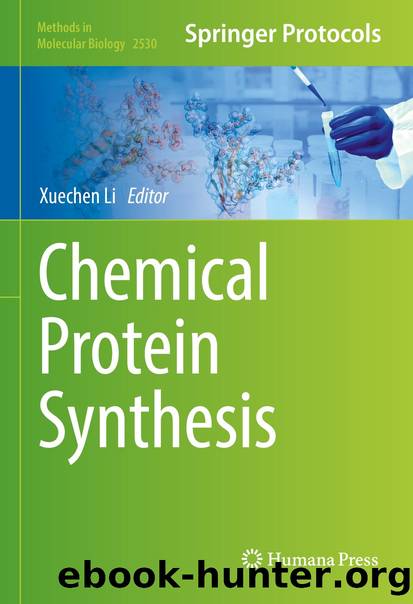Chemical Protein Synthesis by Unknown

Author:Unknown
Language: eng
Format: epub
ISBN: 9781071624890
Publisher: Springer US
The side-chain anchoring strategy utilizes the inherent functionality present on the side chain of a number of proteinogenic amino acids as a âhandleâ to immobilize the residue to the solid support, either directly or through a suitable linker. The C-terminal carboxylic acid is usually protected with an allyl group, due to its orthogonality with Fmoc-solid-phase peptide synthesis (SPPS). After elongation of the desired peptide, allyl deprotection and thio/selenoesterification steps can be conveniently performed on solid support, streamlining the overall process. Since the Fmoc deprotection cannot be performed in the presence of a thio/selenoester, a Boc-protected amino acid is usually coupled at the N-terminus of the peptide. Importantly, this method not only circumvents the solubility issues encountered during solution-phase thio/selenoesterification, but also reduces the epimerization to <1%. The lack of epimerization can be attributed to the proximity of the carboxylate moiety to the solid support blocking the oxazolone pathway [33]. Unfortunately, this method is only applicable for systems featuring a side-chain anchorable amino acid at the C-terminus. These residues (provided in one-letter code) include C, K, N, Q, R, S, T, and Y. However, the applicability of this approach can be improved by implementing a dipeptide-based loading, wherein the C-terminal amino acid can be any amino acid bearing a C-terminal allyl ester and the penultimate residue presents a side-chain anchoring handle, such as C, D, E, K, N, Q, R, S, T, and Y [32â34]. Importantly, these strategies also enable access to bifunctional peptide fragments which are valuable for the synthesis of large proteins involving ligations in either the C â N or N â C direction. If the N-terminal amino acid is incompatible with the thio/selenoesterification conditions, it can be introduced in the end using coupling conditions that do not lead to the hydrolysis of the thio/selenoester moiety [35]. Detailed procedures to prepare peptide thioesters and selenoesters based on aforementioned side-chain anchoring strategies are outlined below.
Download
This site does not store any files on its server. We only index and link to content provided by other sites. Please contact the content providers to delete copyright contents if any and email us, we'll remove relevant links or contents immediately.
| Automotive | Engineering |
| Transportation |
Urban Outlaw by Magnus Walker(2949)
Never by Ken Follett(2877)
OPNsense Beginner to Professional by Julio Cesar Bueno de Camargo(2793)
Sapiens and Homo Deus by Yuval Noah Harari(2410)
Machine Learning at Scale with H2O by Gregory Keys | David Whiting(2278)
A Short History of Nearly Everything by Bryson Bill(2134)
Will by Will Smith(2039)
Hooked: A Dark, Contemporary Romance (Never After Series) by Emily McIntire(1944)
Borders by unknow(1785)
Rationality by Steven Pinker(1763)
Holy Bible (NIV) by Zondervan(1715)
Freedom by Sonny Barger(1485)
The One Percenter Encyclopedia by Bill Hayes(1463)
Five Ways to Fall by K.A. Tucker(1395)
Girls Auto Clinic Glove Box Guide by Patrice Banks(1359)
Far and Near by Neil Peart(1355)
The Becoming by Nora Roberts(1326)
Cuba's Car Culture by Tom Cotter(1324)
A Short History of War by Jeremy Black(1297)
